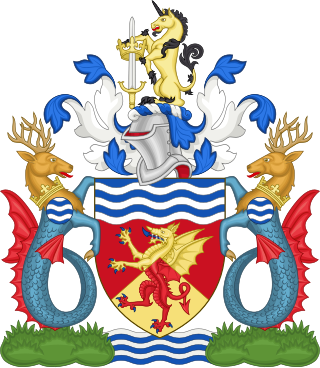
Avon County Council was the county council of the non-metropolitan county of Avon in south west England. It came into its powers on 1 April 1974 and was abolished on 1 April 1996 at the same time as the county. The county council was based at Avon House in Bristol. It was replaced with four authorities: Bristol City Council, South Gloucestershire Council, North Somerset Council and Bath and North East Somerset Council.
Buckinghamshire County Council in England was elected every four years from 1973 until 2020.
Northumberland County Council elections are held every four years. Northumberland County Council is the local authority for the unitary authority of Northumberland in England. Since the last boundary changes in 2013, 67 councillors have been elected from 66 wards.
Oxfordshire County Council is elected every four years.
Lancashire County Council elections are held every four years. Lancashire County Council is the upper-tier authority for the non-metropolitan county of Lancashire in England. Since the last boundary changes in 2017, 84 councillors have been elected from 82 electoral divisions.
Lincolnshire County Council in England is elected every four years.
Norfolk County Council in England is elected every four years. Since the last boundary changes in 2005, 84 councillors have been elected from 84 wards.

Dorset County Council was a non-metropolitan county in England. Elections were first held on 23 January 1889, thereafter elections were held every three years, with all members being elected by the first past the post system of election on the same day. Later, the cycle was changed to one election in every four years, and the last such election was in 2017. There were also occasional by-elections, the last of which took place in December 2016.
Essex County Council in England is elected every four years. Since the last boundary changes in 2005, 75 councillors are elected from 70 wards.
Nottinghamshire County Council elections are held every four years. Nottinghamshire County Council is the upper-tier authority for the non-metropolitan county of Nottinghamshire in England. Since the last boundary changes in 2017, 66 county councillors have been elected from 56 electoral divisions.
Elections to City of York Council were held on 6 May 1999. All 53 council seats in the city were up for election and the Labour Party kept overall control of the council.

Humberside County Council was the county council of the non-metropolitan county of Humberside in northern England.
Elections to City of York Council were held in 2003. The whole council was up for election. Boundary changes had reduced the number of seats from 53 to 47.
Local elections for City of York Council were held on Thursday 3 May 2007. The whole council was up for election. Of the 47 seats contested, the Liberal Democrats won 19 seats, Labour won 18 seats, Conservatives won eight seats and the Green Party won two seats. The election saw York's ruling Liberal Democrats lose ten seats and overall control of the council.

Cleveland County Council was the county council of the non-metropolitan county of Cleveland in north east England. It came into its powers on 1 April 1974 and was abolished on 31 March 1996.
Elections to the new City of York unitary authority were held on 4 May 1995, although the new unitary authority wasn't officially created until April 1996. All 53 council seats in the city were up for election and the Labour Party won overall control of the council.
Isle of Wight Council is the local authority for the Isle of Wight, a unitary authority and non-metropolitan county in England. Since the last boundary changes in 2021 the island has been divided into 39 electoral divisions, each of which elects one councillors. Elections are held every four years.

The 1993 Avon County Council election took place on 6 May 1993 to elect members of Avon County Council in England. This was on the same day as other nationwide local elections. The Liberal Democrats made a number of gains, mainly at the expense of the Conservatives. Labour remained the largest group on the council, but were 6 seats short of gaining a majority.

The 1989 Lincolnshire County Council election was held on Thursday, 4 May 1989. The whole council of 76 members was up for election and the election resulted in the Conservative Party retaining control of the council and winning the same number of seats as the previous election in 1985, with 39 seats.
Elections to Hertfordshire County Council were held on 6 May 1993, at the same time as other elections to county councils across England and Wales. All 77 seats on the county council were up for election.






